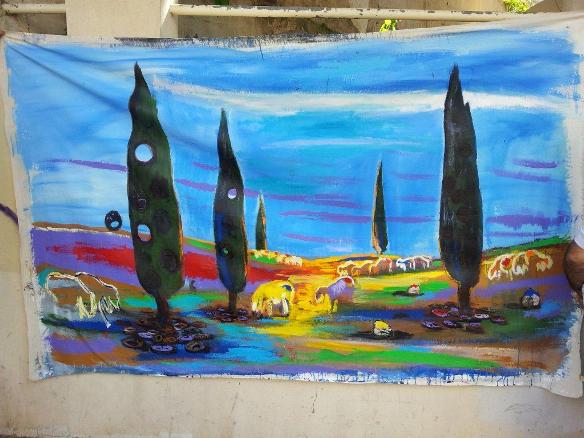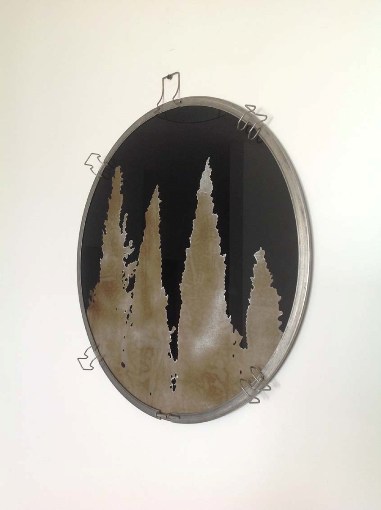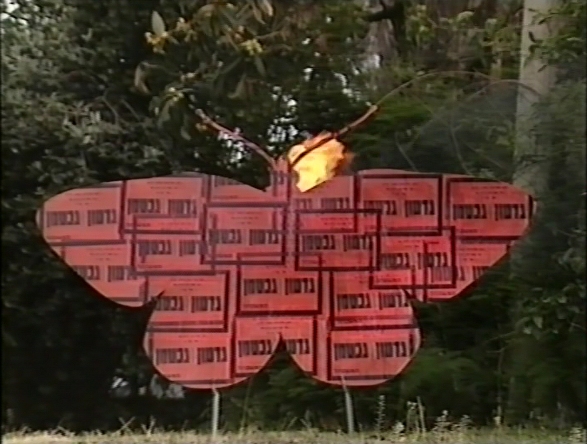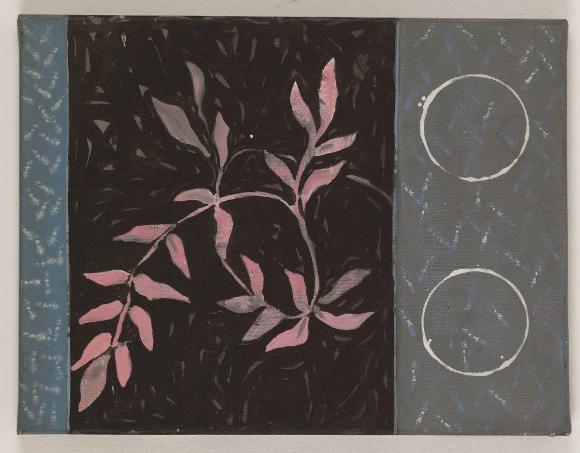This exhibition opened well before the start of Operation Pillar of Defense. But its pervading atmosphere, one of sadness and hopelessness, seems to echo the feelings of many Israelis this week. In addition, whilst only four artists are represented here, undoubtedly there are many more out there whose motifs and myths deal with identical themes.

Menashe Kadishman, one of the first Israeli artists to deal from a critical standpoint with the subject of war and bereavement, is represented by a large and colorful landscape featuring sheep grazing beneath cypress trees. Below the trees – and also on the floor of the gallery alongside the picture – are tiny discs, each impressed with the pathetic cipher of a human face, mouth parted in a scream. These images are derived from Kadishman’s version of the Sacrifice of Isaac in which angel does not stay Abraham’s hand, so Isaac dies. (Shalechet – Fallen Leaves, a permanent installation at the Jewish Museum, Berlin, displays 10,000 of these heads cast in Corten steel.) From repetition and over- exposure, Kadishman’s imagery tends to descend into kitsch. But this particular painting gets to the heart of the matter.

Butterflies, creatures that signify both beauty and frailty, are recurring motifs in sculptures and wall works by Etamar Beglikter whose show The Messenger held early last year dwelt on death and bereavement. The same themes are presented here. But, in this instance, it was the deadly fires on Mount Carmel in December 2010 that Beglikter sought to memorialize. Alongside portraits of the blackened face of one specific victim of this disaster, he shows a row of three-dimensional butterflies cut out from the pages of illustrated encyclopedias, history and art books. This symbolic demolition of our cultural heritage is clearly part of Beglikter’s expressive scheme, but nevertheless, at least for this viewer, it is still painful to accept. One turns instead to his skilful paintings depicting the images of burnt trees in which tar was used instead of regular paint. Not to be missed too, is an architectural model (also employing tar) of blackened buildings set within a rural landscape, perhaps meant to represent Kibbutz Bet Oren which was partially destroyed by the fire. This model is a homage to Meir Gur-Arie, a prominent ‘Bezalel’ artist from the first quarter of the 20th century. The inclusion of two figures in this ‘stage set’ refers to a well known series by Gur-Arie depicting the silhouettes of Zionist pioneers.

A still of a burning, disintegrating butterfly from a video by the late Gideon Gechtman (d. 2008) dovetails neatly into this exhibition’s theme. For decades, starting with his first solo show in 1973 at the Yodfat Gallery, Tel Aviv, documenting preparations for his heart operation, Gechtman’s art dealt with death, memory and commemoration. Amongst other happenings instigated by him, Gechtman published announcements of his death and set about designing his own mausoleum. For this effective piece, Gechtman and his son Yotam (who died a few years before his father) stamped obituary notices onto the body of the butterfly.

Memories of places and objects are the starting point for small sculptures and canvases by Arie Berkowitz, artist, educator and set designer. Together, these sculptures have been given the title Urban Landscape. Dating from 2010, they are fashioned from cast off strips of wood, with dark shapes painted onto their surfaces suggesting elements in Nature such as a tree, leaves, and the sky. Like Bicycle Ride, an earlier set of works by Berkowitz, this set of works appear to relate to objects that flash by one’s eyes, and then are lodged only as fragments in the memory.
The concept of fading recollections is also a feature of Berkowitz’s paintings; large minimalist compositions in somber colors ranging from black to purple. Against a neutral background, each of them hints at objects associated with home: the lacey edge of a tablecloth, plates, vases, a trailing plant – seen as if through a veil. These are not necessarily unhappy memories. But within the context of this exhibition, this writer cannot help but associated this set of paintings with more poignant depictions of family meals in Israeli art, in particular, Naftali Bezem’s 1998 painting, The Last Shabbat.
Curated by Orit Lottinger, this exhibition impresses for its careful selection of meaningful works. Till Nov. 29th. Municipal Art Gallery, Kfar Saba, 12 Geula St., 09.7649303





